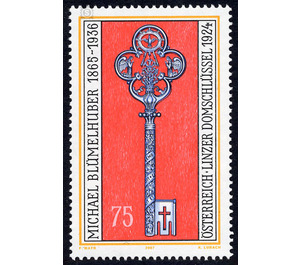art - Austria / II. Republic of Austria 2007 - 75 Euro Cent
Theme: Devices, Items & Instruments
| Country | Austria / II. Republic of Austria |
| Issue Date | 2007 |
| Face Value | 75.00 |
| Edition Issued | 420,000 |
| Printing Type | combination printing |
| Stamp Type | Commemorative |
| Item Type | Stamp |
| Chronological Issue Number | 2025 |
| Chronological Chapter | OOS-OE2 |
| SID | 337859 |
| In 55 Wishlists | |
Artful processing of iron existed in antiquity, primarily as a surface decoration on weapons and armor. In addition to engraving, iron cutting became increasingly important. It involves a machining of the iron with hardened small tools such as chisel, graver, drill, file and punch. Since the end of the 19th century, steel cutting has been used because of the refinement of the iron. In Steyr, since the Middle Ages the headquarters of the blade forge, developed the art of iron cutting. In the Rococo period, this art was forgotten and was not resurrected until the end of the 19th century by the artists Gustav Ritzinger, Leo Zimpel and Michael Blümelhuber. In the 20th century, especially Hans Gerstmayr and Friedrich Mayr stood out. The latter has also emerged as the designer of a number of Austrian special stamps, including this brand. Michael Blümelhuber, b. 1865 in Unterhimmel (Christ Child) near Steyr, died 1936 in Steyr, is referred to as the greatest master of iron or steel section. It was his crucial craft and artistic achievement that for the first time in the centuries-old history of iron cutting, he cut his works from the full material. State, land and the city Steyr built the master studio for steel cutting, the Landeskunstschule, into which Blümelhuber moved in 1910 - today a branch of the HTL Steyr "Fachschule für Metalldesign". Blümelhuber created hunting knives, cutlery, scissors, letter openers and jewelery. His major works, however, were primarily symbolic sculptures. Some of his works have been lost since World War II. The 29 cm large cathedral key is the most famous work of the master. Made from a steel block weighing more than 2 kg, the finished piece weighs only half a kilogram. Blümelhuber created the key in 1924 for the inauguration of the Maria Conception Cathedral in Linz. The beard of the key is the most important part. Blümelhuber cut the cross out of his beard. Beating roots next to the cross, the flower of love - the rose - rises up at the broken key shaft, together with the banner "APERIT ET NEMO CLAUDIT; CLAUDIT ET NEMO APERIT ". That He opens and nobody closes, he closes and nobody opens. In the key handle, a bouquet of lilies blossoms, a symbol of purity and innocence. Above that, the Holy Spirit hovers as a dove. An angel kneels in each of the two middle four-roundings, he adores the lily with folded hands - the mystery of the Blessed Mother. The Domschlüssel, which has been in the possession of the Upper Austrian Provincial Museum since 1924, was handed over to Bishop Aichern of Linz in 1985 and is now in his intended homestead, the Maria-Gedächtnis-Dom zu Linz.


